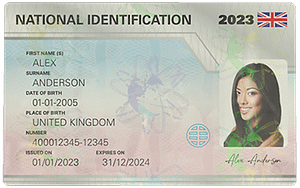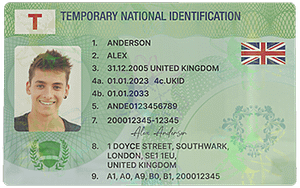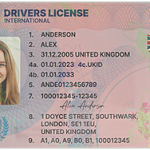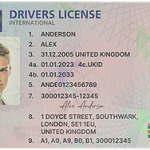Retailers play a crucial role in maintaining the integrity of age – restricted sales. One of the key challenges they face is the prevalence of fake ID cards. Training staff to accurately detect these counterfeit documents is of utmost importance. Here’s a look at how retailers are approaching this task.
Understanding the Basics of ID Card Structure
The first step in training is to familiarize staff with the standard structure of a legitimate ID card. Different regions have their own specific design elements. For example, most government – issued ID cards have a combination of printed and holographic elements. Staff are taught to recognize the type of paper or plastic used in real ID cards. Genuine ID cards are typically made from high – quality materials that have a certain texture and thickness. Fake ID cards, on the other hand, may be made from cheaper materials that feel flimsy or have an unusual texture.
Another important aspect is the layout of information on the ID card. Legitimate IDs usually have the name, date of birth, address, and a photo of the cardholder arranged in a specific and consistent manner. Retailers train their staff to look for any inconsistencies in the layout, such as misaligned text or an oddly placed photo.

Examining Holographic and Security Features
Holographic elements are a common security feature on ID cards. Retailers train their employees to be able to identify genuine holograms. Real holograms often have a three – dimensional appearance and change colors or patterns when viewed from different angles. Fake holograms may look flat or have a lower – quality finish. Staff are also educated about other security features like microprinting. Microprinting is tiny text that is difficult to reproduce accurately on a fake ID. This text may be found in various parts of the ID card, such as around the border or within the background design.
Some ID cards also have UV – reactive features. Retailers provide their staff with UV lights to check for these elements. Genuine ID cards will have certain parts that glow or show specific patterns under UV light, while fake ones may not react in the same way or may have a different, inconsistent reaction.
Verifying the Photo and Physical Appearance Match
One of the most straightforward but crucial checks is to ensure that the photo on the ID card matches the person presenting it. Retailers train their staff to look for similarities in facial features, hair color, and general appearance. However, they also need to be aware of the possibility of photo – shopping or other forms of manipulation. Staff are taught to look for signs of a poorly edited photo, such as uneven skin tones around the edges of the face or a different lighting quality in the photo compared to the rest of the ID card.

In addition to the photo, staff are trained to compare the physical appearance of the person in front of them with the information on the ID card. For example, if the ID card indicates that the cardholder is a certain height or has specific distinguishing features like tattoos or piercings, they can check if these match the person presenting the ID.
Training on Regional and State – Specific ID Features
Since ID card designs vary from region to region and state to state, retailers ensure that their staff are well – versed in the specific features of the IDs they are likely to encounter. For instance, in some states, the ID card may have a unique watermark or a specific color scheme. Staff are provided with sample ID cards from different regions and are trained to recognize these distinctive features. This knowledge helps them quickly identify an ID as genuine or suspect.
Retailers also keep their staff updated on any changes or new security features that are introduced in different states’ ID cards. This could involve regular training sessions or providing access to online resources that detail the latest ID card designs and security measures.
Role – Playing and Real – Life Simulations
To make the training more practical, retailers often use role – playing and real – life simulations. Staff are presented with a variety of fake and real ID cards in different scenarios. They are then asked to determine whether each ID is genuine or not. This hands – on experience helps them apply the knowledge they have gained in a more realistic setting. After each simulation, feedback is provided, and any areas of confusion or misidentification are discussed to improve the staff’s skills.
Retailers may also collaborate with local law enforcement agencies or security experts to conduct mock raids or inspections. During these exercises, staff are exposed to a wide range of counterfeit ID cards and are given the opportunity to interact with individuals presenting these fake documents. This not only hones their detection skills but also helps them develop the confidence to confront and handle such situations in real – life retail environments.
Common Problems and Solutions
- Problem: Staff are overwhelmed by the number of security features to check
Solution: Retailers break down the training into smaller, more manageable modules. They start with the most basic and easily recognizable features, such as the photo and general layout, and gradually introduce more complex security elements like holograms and UV – reactive features. Staff are also provided with cheat sheets or quick – reference guides that summarize the key features to check. - Problem: Difficulty in differentiating between high – quality fake ID cards and genuine ones
Solution: Retailers regularly update their training materials with examples of the latest and most sophisticated fake ID cards. They also invite experts, such as forensic document examiners, to conduct in – depth training sessions on how to spot the细微 differences between real and fake IDs. Additionally, staff are encouraged to report any suspicious IDs they encounter so that these can be analyzed and used as case studies for future training. - Problem: Staff may be intimidated by individuals presenting fake ID cards
Solution: Retailers provide training on conflict – resolution and customer – service skills. Staff are taught how to handle difficult or confrontational situations in a calm and professional manner. They are also informed about their rights and the appropriate steps to take when they suspect an ID is fake, such as asking for additional identification or contacting local law enforcement if necessary. - Problem: Inconsistent training across different store locations
Solution: Retailers implement a standardized training program that is delivered uniformly across all their stores. This may involve using online training platforms that ensure all staff have access to the same materials and resources. Regular audits are also conducted to check the effectiveness of the training and to identify any areas where additional support may be needed. - Problem: Staff forget the training over time
Solution: Retailers schedule regular refresher courses for their staff. These courses review the key points of ID card detection and may also introduce new security features or trends in fake ID production. Staff are also encouraged to stay updated on the latest news and information related to ID card security through internal newsletters or online resources provided by the retailer.



